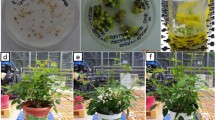Abstract
White and blue/white varieties of Torenia hybrida were successfully obtained from the blue variety cv. Summerwave (SWB) by cosuppressing expression of two of the genes involved in anthocyanin biosynthesis; chalcone synthase (CHS) and dihydroflavonol 4-reductase (DFR). Such molecular breeding is the only precise and efficient way to create flower color variation in SWB due to its male and female sterility. Flower color and the degree of suppression varied between transgenic lines, and anthocyanin biosynthesis was more consistently suppressed in the dorsal petal lobes, ventral petal lobes and corolla tube than lateral petal lobes. A pink variety was obtained by cosuppressing the flavonoid 3′,5′-hydroxylase (F3′5′H) gene. Yellow torenia was obtained from T-33, an in-house cultivar that contained both carotenoids and anthocyanins, by cosuppression of CHS or DFR genes.
Similar content being viewed by others
References
Aida R, Shibata M: Agrobacterium-mediated transformation of torenia (Torenia fournieri). Breed Sci 45: 71-74 (1995).
Bartley GE, Scolnik PA: Plant carotenoids: pigments for photoprotection, visual attraction, and human health. Plant Cell 7: 1027-1038 (1995).
Brugliera F, Holton TA, Stevenson TW, Farcy E, Lu CY, Cornish EC: Isolation and characterization of a cDNA clone corresponding to the Rt locus of Petunia hybrida. Plant J 5: 81-92 (1994).
Courtney-Gutterson N, Napoli C, Lemieux C, Morgen A, Firoozababy E, Robinson KEP: Modification of flower color in florist's chrysanthemum: production of a white-flowering variety through molecular genetics. Bio/technology 12: 268-271 (1994).
Depicker A, Van Montagu M: Post-transcriptional gene silencing in plants. Curr Opin Cell Biol 9: 373-382 (1997).
Deroles SC, Bradley JM, Schwinn KE, Markham KR, Bloor S, Manson DG, Davis KM: An antisense chalcone synthase cDNA leads to novel colour patterns in lisianthus (Eustoma grandiflorum) flowers. Mol Breed 4: 59-66 (1998).
Forkmann G: Flavonoids as flower pigments: The formation of the natural spectrum and its extension by genetic engineering. Plant Breed 106: 1-26 (1991).
Fujiwara H, Tanaka Y, Fukui Y, Nakao M, Ashikari T, Kusumi T: Anthocyanin 5-aromatic acyltransferase from Gentiana triflora. Eur J Biochem 249: 45-51 (1997).
Fukuda-Tanaka S, Hoshino A, Hisatomi Y, Habu Y, Hasebe M, Iida S: Identification of new chalcone synthase genes for flower pigmentation in the Japanese and common morning glories. Plant Cell Physiol 38: 754-758 (1997).
Gutterson N: Anthocyanin biosynthetic genes and their application to flower color modification through sense suppression. HortScience 30: 964-966 (1995).
Helariutta Y, Elomaa P, Kotilainen M, Seppanen P, Teeri TH: Cloning of cDNA for dihydroflavonol-4-reductase (DFR) and characterization of dfr expression in the corollas of Gerbera hybrida var. Regina (Compositae). Plant Mol Biol 22: 183-193 (1993).
Holton TA, Brugliera F, Lester DR, Tanaka Y, Hyland CD, Menting JGT, Lu CY, Farcy E, Stevenson TW, Cornish EC: Cloning and expression of cytochrome P450 genes controlling flower colour. Nature 366: 276-279 (1993).
Holton TA, Cornish EC: Genetics and biochemistry of anthocyanin biosynthesis. Plant Cell 7: 1071-1083 (1995).
Jorgensen RA, Cluster PD, English J, Que Q, Napoli CA: Chalcone synthase cosuppression phenotype in petunia flowers: comparison of sense vs. antisense constructs and singlecopy vs. complex T-DNA. Plant Mol Biol 31: 957-973 (1996).
Mitsuhara I, Ugaki M, Hirochika H, Ohshima M, Murakami T, Gotoh Y, Katayose Y, Nakamura S, Honkura R, Nishimiya S, Ueno K, Mochizuki A, Tanimoto H, Tsugawa H, Otsuki Y, Ohashi Y: Efficient promoter cassetes for enhanced expression of foreign genes in dicotyledonous and monocotyledonous plants. Plant Cell Physiol 37: 45-59 (1996).
Mol J, Stuitje A, Gerats A, van der Krol A., Jorgensen R: Saying it with genes: Molecular flower breeding. Trends Biotechnol 7: 148-153 (1989).
Murashige T, Skoog F: A revised medium for rapid growth and bioassay with tobacco tissue cultures. Physiol Plant 15: 473-497 (1962).
Napoli C, Lemieux C, Jorgensen R: Introduction of chimeric chalcone synthase gene into petunia results in reversible cosuppression of homologous genes in trans. Plant Cell 2: 279-289 (1990).
Que Q, Wang HY, Jorgensen RA: Distinct patterns of pigment suppression are produced by allelic sense and antisense chalcone synthase transgenes in petunia flowers. Plant J 13: 401-409 (1998).
Sambrook J, Fritsch EF, Maniatis T: Molecular Cloning: A Laboratory Manual, 2nd ed. Cold Spring Harbor, Laboratory Cold Spring Harbor, NY (1989).
Shirley BW: Flavonoid biosynthsis:'new' functions for an 'old' pathway. Trends Plant Sci 1: 377-381 (1996).
Stam M, de Bruin R, Kenter S, van der Hoorn RAL, van Blokland R, Mol JNM, Kooter JM: Post-transcriptional silencing of chalcone synthase in Petunia by inverted transgene repeats. Plant J 12: 63-82 (1997).
van Blokland R, van der Geest N, Mol JNM, Kooter JM: Transgene mediated suppression of chalcone synthase expression in Petunia hybrida results from an increase in RNA turnover. Plant J 6: 861-877 (1994).
van der Krol AR, Lenting PE, Veenstra J, van der Meer IM, Koes RE, Gerats AGM, Mol JNM, Stuitje AR: An antisense chalcone synthase gene in transgenic plants inhibits flower pigmentation. Nature 333: 866-869 (1988).
van der Krol AR, Mur LA, Beld M, Mol JNM, Stuitje AR: Flavonoid genes in petunia: addition of a limited number of gene copies may lead to a suppression of gene expression. Plant Cell 2: 291-299 (1990).
Author information
Authors and Affiliations
Rights and permissions
About this article
Cite this article
Suzuki, Ki., Xue, Hm., Tanaka, Y. et al. Flower color modifications of Torenia hybrida by cosuppression of anthocyanin biosynthesis genes. Molecular Breeding 6, 239–246 (2000). https://doi.org/10.1023/A:1009678514695
Issue Date:
DOI: https://doi.org/10.1023/A:1009678514695




